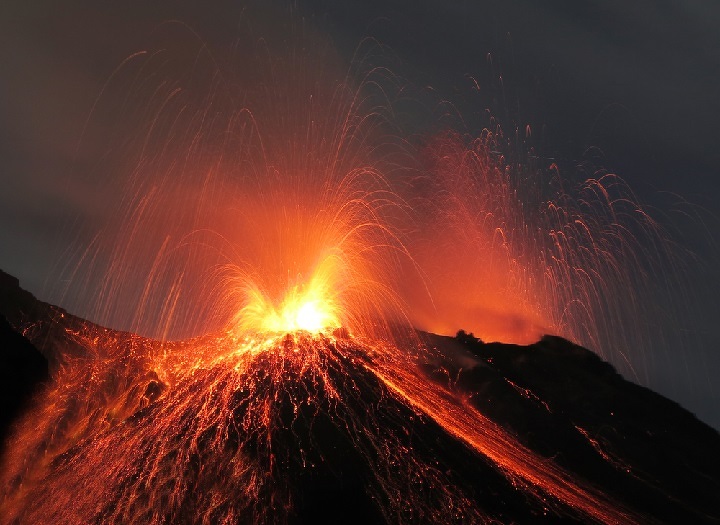Here's How To Actually Cook Food Over Lava

Whether you’re a carnivorous beastie or a vegetarian, vegan, pescatarian or whatever, the basics are the same. All you need is some lava, and some food. It helps, quite a lot, if you’re not clumsy.
Just to make it a little easier, I’m going to talk about steak here, but similar warnings/advice applies to anything that you hope to digest. Now, let’s find a fresh lava flow. Hawaii’s probably the best place to go for this, unless you have a laboratory that actually creates its own lava – yes, these do exist – so hop on a plane there, and clamber up to one of the lava flows that have been emerging from Kilauea since 1983.
Get a wide grill, one with flat, heatproof bases on the prongs. If you stand on a freshly cooled lava flow, and you stick a thin metal pole in the ground, it will likely crack open the blackened surface and reveal molten lava. This may melt your grill, as well as your feet. So, place your grill over the lava flow carefully, and be prepared to move it as the lava flow moves. Cook and dance.
Hey, I didn’t promise that this would be easy.
Whatever you’re cooking, you’re also going to have to contend with the fact that you’re not using a regular grill; it’s more of a dragon, really. On a very high heat, barbeque grills fuelled by natural gas can reach temperatures of around 232°C (450°F). The average temperature of basaltic lava is around 1,100°C (2,012°F).

The New Nuclear Danger
As someone who was born in 1948, the risk of a nuclear World War III was a ... →
If you’re one of those monsters that likes your steak well done, then this works perfectly for you – but if you’re more rational when it comes to your gastronomic proclivities, then this extra-powerful heat source will need to be handled with care.
Say you’ve got a skirt steak. Why a skirt steak, you may ask? Because Gordon Ramsey has told me that it’s tender and soft and a chef’s dream, and I’m too frightened to disagree with him – plus, he does seem to know what he’s talking about.
In this video, after marinating and seasoning the hell out of it, he places the thin skirt steak on an already piping-hot grill for just a couple of minutes on both sides, and then it’s done.
If you allowed a grill over a lava flow to get to its maximum temperature, and then you plonk a skirt steak on the grill, it would sear instantly, and maybe become leatherized. The outside would be black; the inside would be bloody. You’ve ruined it. Your guests, already terrified by the lava sneaking up around them, would be most displeased.
In fact, placing any kind of meat less than a foot above a fresh lava flow, as this video shows, will set it alight. Top tip: get a high grill. Flame-grilled is one thing, but thanks to the fat dripping down onto the lava flow and triggering a fiery outburst, those poor steaks are burned in the fires of hell. Right at the conclusion of the video, one poor steak is cooked on top of a recently cooled lava flow itself. I say cooked – I mean cremated.

What Makes a Human?
Last month, moviegoers flocked to theaters to see War for the Planet of the... →
The volcanic maestros in the video chuck some salmon on the grill of doom too, but the skin gets stuck to the metal as if it’s ironically clinging on for dear life.
One of those involved in that project was an experimental chef, who claimed that the steak was perfectly cooked. He’d already given it a go over a lava flow at Sakurajima in Japan, and decided to approach a sculptor/geologist team at Syracuse University to do it again. Those mavericks are certainly winning points for making their own lava, but I’d pay good money to see Ramsey (quite rightly) explode their eardrums. They didn’t even season the poor things.
In any case, if you really do go to Hawaii and give this a try, remember: use a high grill, make sure it has heatproof platforms on the grill stand prongs, don’t try out fish, and don’t be clumsy. Oh yes, sulphur compounds are also a frequent effusion from volcanic flows. Not only are these quite bad for your respiratory system and your eyes, they also smell and taste quite a lot like extremely rotten eggs. If you don't want your food to taste this bad, then either use a fan to blow the fumes away as you grill, or add some sort of sweet marinade - or even just sugar - to the food to neutralize the acids.
One last thing – don’t use anything with much water in it. Water falling onto lava will create quite violent steam eruptions. Not only will this, well, steam your food quite excessively, but it will also cause little eruptions of lava that will spit out at you. Again, this is not exactly desirable.
Bon appétit - and remember, watch your feet.
Robin Andrews, Contributor

